Ultimate Guide for Athletes: Sleep & Exercise, Training, and Recovery
More and more athletes at the top of their game are relying on a performance-enhancing — drug free — supplement: healthy, restful sleep.
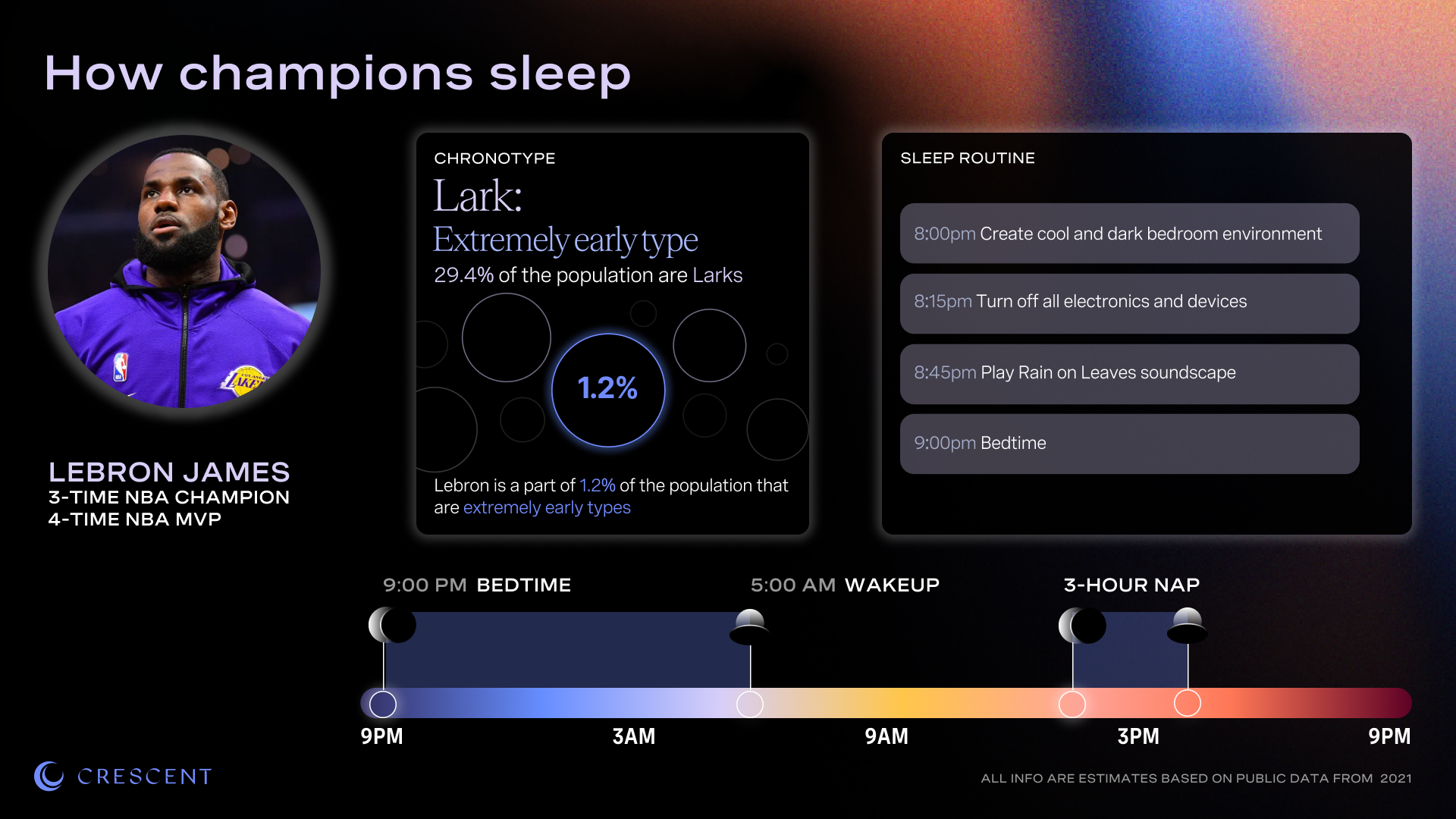
In his 2017 book The TB12 Method: How to Achieve a Lifetime of Sustained Peak Performance, Tom Brady – the winningest QB in the NFL — revealed details of his health and wellness regimen — including the recipe for his go-to morning smoothie. Another secret weapon? A strict sleep schedule: in bed at 9 p.m. and up at 6 a.m., logging an impressive 9 hours of sleep each night.
Lakers superstar Lebron James’s dedication to getting 12+ hours of sleep per night is also legendary, and has famously led his teammates to joke that basically James is either playing basketball or sleeping.
And then there’s Serena Williams, 23-time Grand Slam tennis champion, who believes that quality sleep is key if you want to exceed the expectations that come with being a female role model.
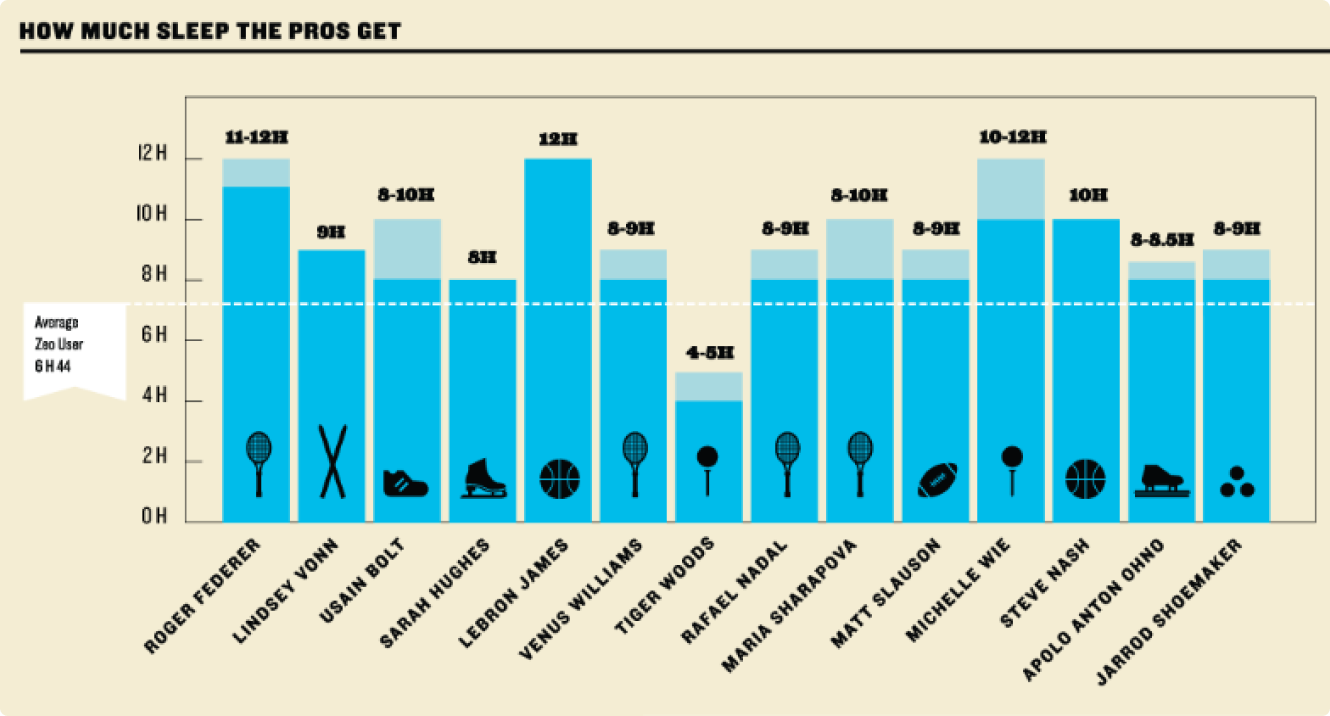
"Sleep is half my training" - Jarrod Shoemaker, professional triathlete
In the last few years, more and more athletes at the top of their game (or heading in that direction) have taken a page from Brady, James, and Williams’ book and incorporated a performance-enhancing — drug free — supplement into their training routines: healthy, restful sleep.
And while good-quality sleep unequivocally enhances performance, athletes who are sleep deprived face increased risk of injury and illness; decreased accuracy, reaction time, and ability — not to mention impaired cognitive function, including difficulty with learning and decision-making. All essential if you want to become the greatest of all time.
Athletes who sleep more and sleep better perform better, both in the short and the long term, says Amy Bender, PhD, an expert in sleep and performance who has studied and worked with NBA, NHL, NFL, and Olympic athletes throughout Canada and the U.S.
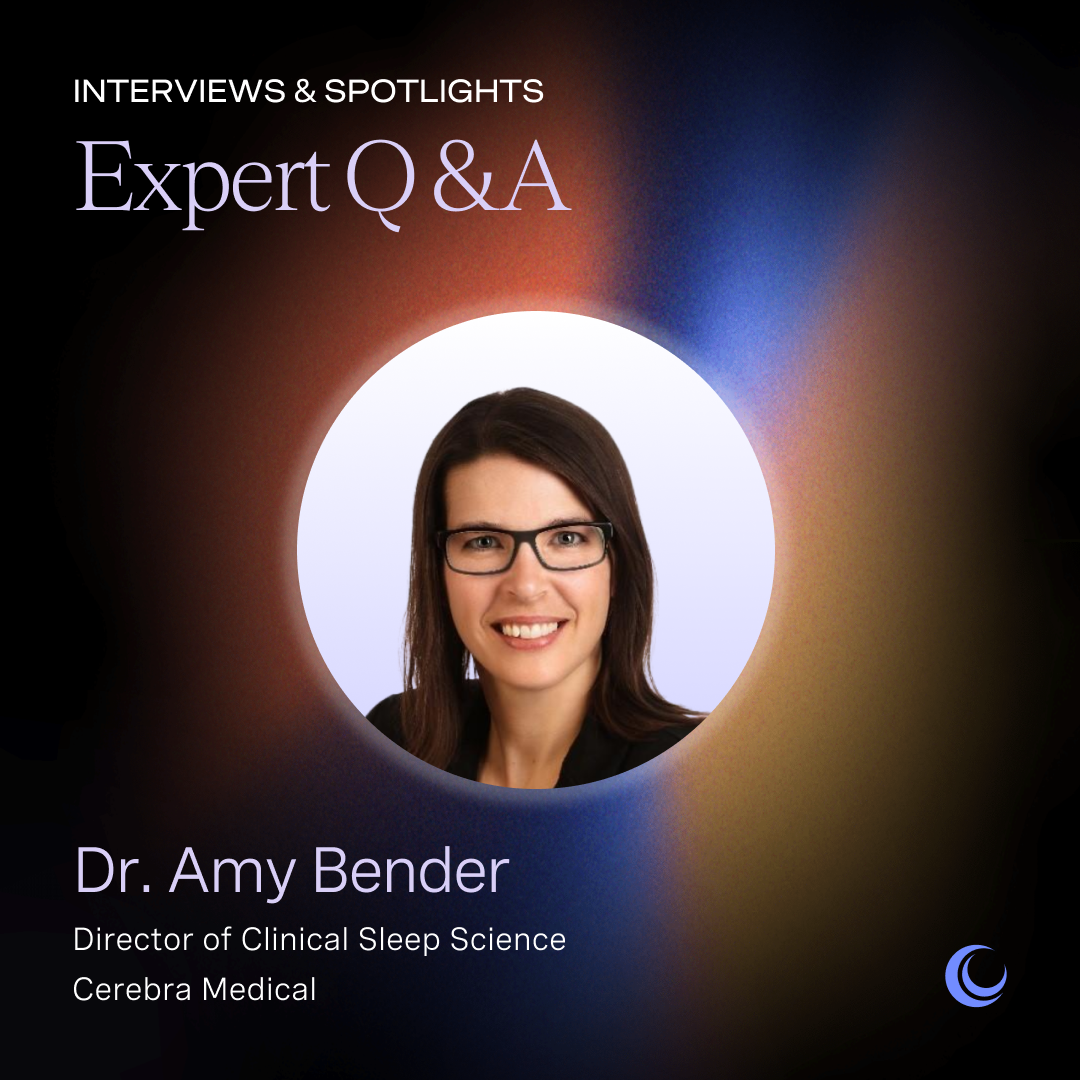
Though you might not need 10 to 12 hours like these GOATs, you should shoot for seven to nine if you’re looking to bring your A game.
In this guide, we do a deeper dive into the link between performance, training, recovery, and sleep.
What is the relationship between exercise and sleep?
Sleep is essential for your body to recover and perform at its best. During deep sleep, your body repairs muscle tissue and produces growth hormones that allow muscles to strengthen.
When we get quality sleep, our bodies also replenish muscle glycogen, a critical energy source that gets depleted when we work out. While you sleep, you'll also solidify new skills and muscle memory for exercises you've been practicing.
And it works both ways: Exercise has been shown to improve the quality of your sleep.
The more sleep pressure we accumulate throughout the day, the easier it is for us to fall asleep in the evening. Additionally, after we exercise, ideally in the morning or early afternoon, we enable our core body temperature to more quickly decrease, which allows us to fall asleep and achieve deeper rest more easily.
Learn more:

Which types of exercise are better for sleep?
Nearly every sleep specialist you ask will tell you that regular aerobic activity can help you sleep better. However a recent study by Angelique Brellenthin, PhD, professor of kinesiology at Iowa State University, finds that resistance exercises that work on strengthening muscle may actually be better than aerobic workouts for improving the duration and quality of your sleep.
"We found that resistance exercise appeared to go above and beyond aerobics or even a combined aerobic and resistance routine on several different sleep outcomes," she said, adding, "Our study is one of the largest and longest exercise trials in a general adult population to directly compare the effects of different types of exercise on multiple sleep parameters."
The year-long study included 386 people who were randomly assigned to four groups: no-exercise, cardio only, strength training only, or a combination of cardio and strength training. During those 12 months, study participants in each of the exercise groups completed 3 60-minute workouts per week. Cardio workouts were done on treadmills, stationary bikes, and elliptical machines. Strength-training sessions used 12 resistance machines that worked all major muscle groups.

At the start of the study and then again at the 12-month mark, participants rated their sleep quality using the Pittsburgh Sleep Quality Index, a validated self-assessment designed to measure seven domains of sleep (such as duration, sleep disturbances, and restfulness). At the start of the study, data showed that 35% of participants struggled with sleep issues. After 12 months, everyone on average reported better sleep (including the control group that did not do supervised workouts). But the improvements were not equal across the groups.
Why is resistance exercise better than aerobics for improving sleep?
Learn more:
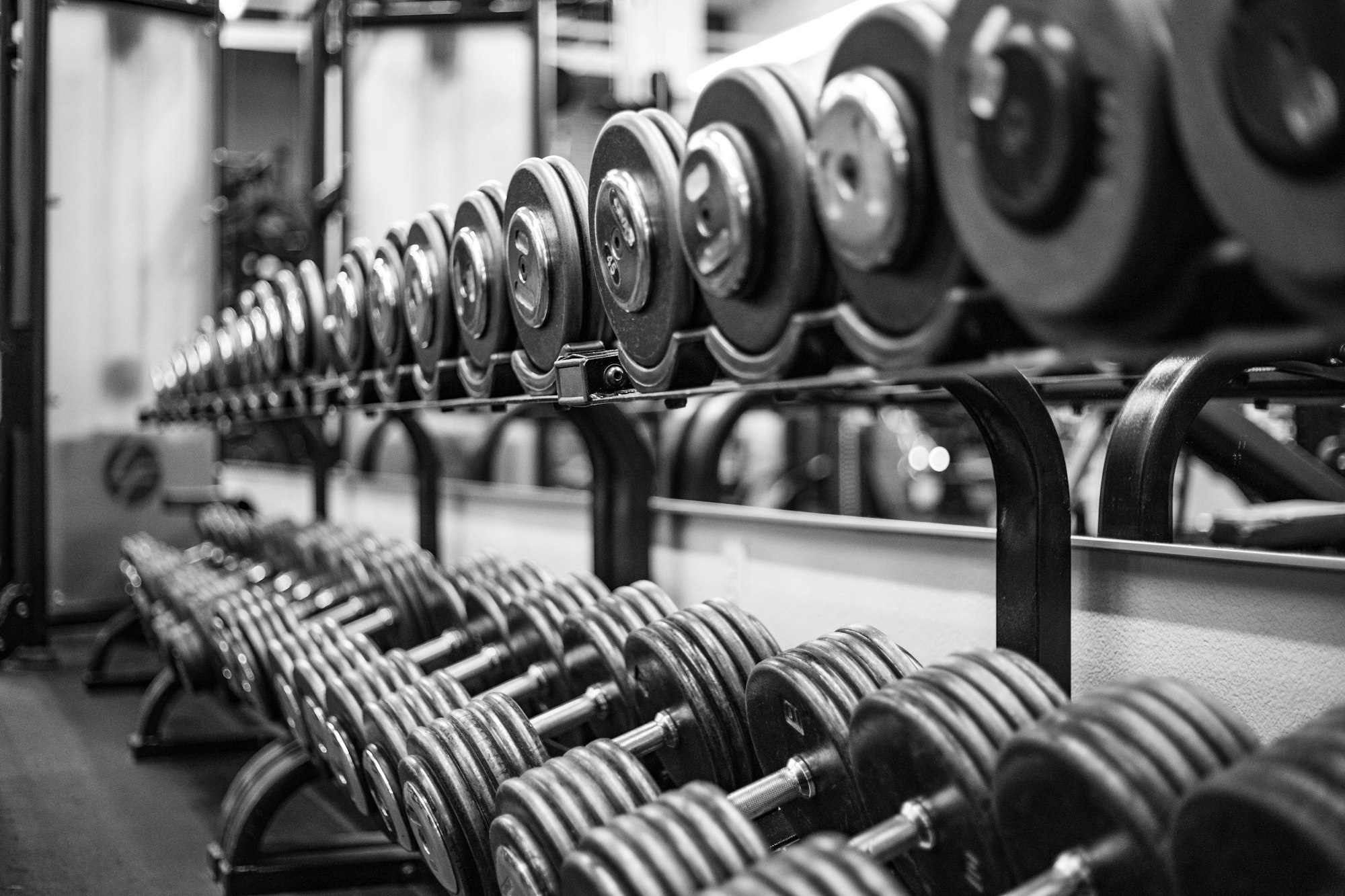
Sleep, muscle growth, and recovery
Sleep is where the magic happens for your muscles, including their growth and recovery.
Research confirms that regular and adequate sleep helps repair and restore muscles, increases muscle strength and mass, and improves athletic performance.
With so many benefits, sleep should be an integral part of every athlete’s and exercise enthusiast’s workout regimen.
Getting enough sleep is important for muscle recovery because that’s when the body releases most of its human growth hormone (HGH). During slow wave/non-REM sleep, the pituitary gland secretes about 60 to 75% of the HGH it makes. The HGH goes to work stimulating tissue growth, helping to repair muscle and tissue from the wear and tear that happened throughout the day, or during exercise. HGH has also been shown to be a key player in helping to heal damage to tendons and ligaments by synthesizing collagen.
According to a study published in the Journal of the American Medical Association, the more deep sleep you get, the more HGH is released. Conversely, when you skimp on sleep, there’s less growth hormone secretion. According to another study, a deficiency of HGH is linked to loss of muscle mass and reduced exercise capacity. It’s worth noting that both HGH and slow wave sleep naturally decrease as we age.
New research has begun exploring the importance of sleep and how a lack of sleep may lead to loss of muscle mass and decrease muscle recovery.
One study found that a group of men who were sleep deprived and then exercised had less myofibrillar protein synthesis, which would likely result in decreased muscle mass over time. Another study found a broader relationship with sleep duration and muscle mass. That study compared two groups of people that either slept 5.5 or 8.5 hours while reducing their caloric intake. The shorter-sleep group lost more muscle mass than fat. Whether it is through myofibrillar protein synthesis or other pathways, it’s clear that sleep and muscle growth and recovery are closely linked.
The last pathway that highlights how sleep encourages muscle recovery is through inflammation cells called cytokines. Studies have shown that exercise followed by sleep deprivation was associated with an increase in a particular type of cytokines, which can contribute to chronic inflammation and hinder muscle recovery if the sleep deprivation continues long-term.
Learn more:
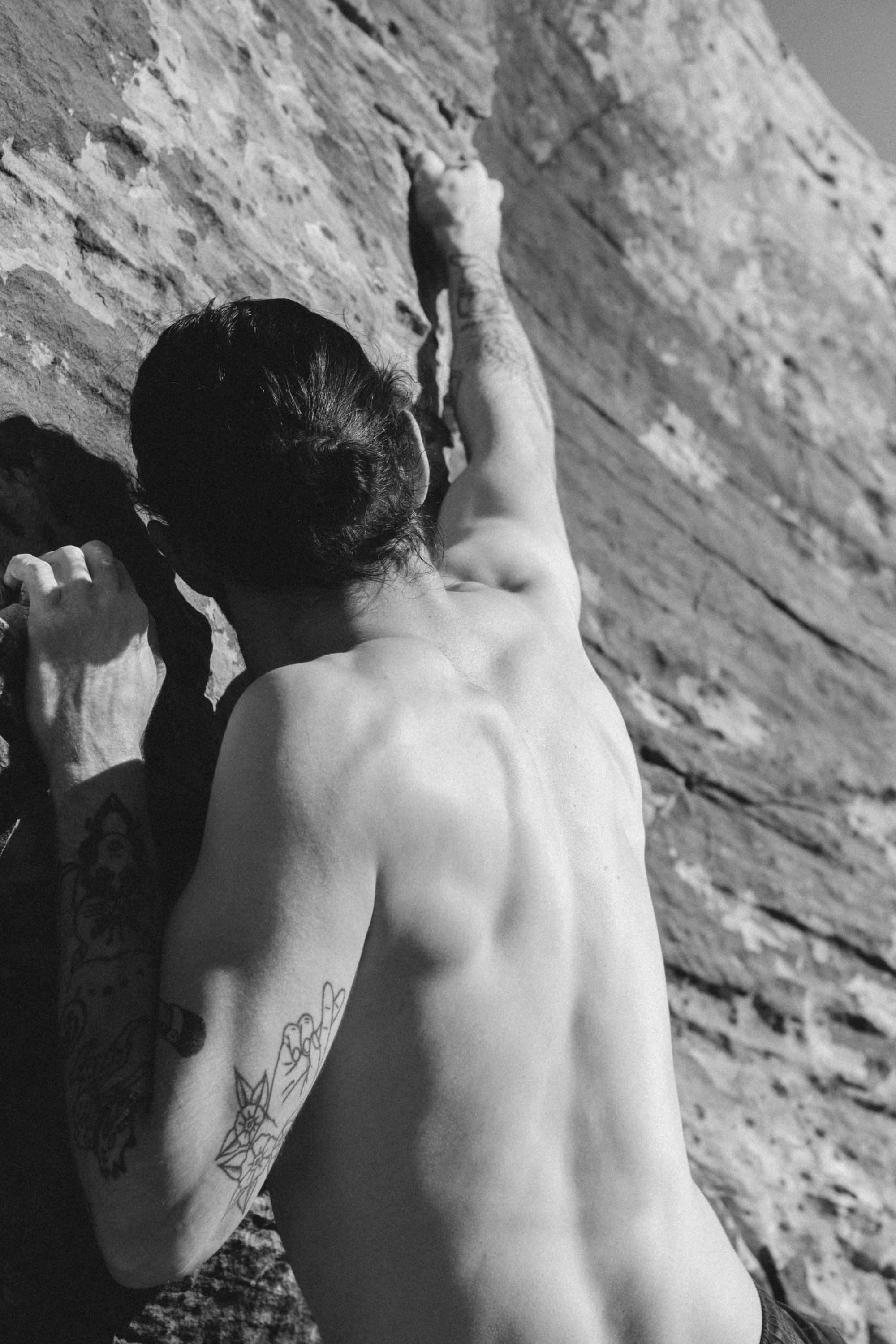
Sleep and athletic performance
More and more studies attest that sleep is a crucial part of maximizing athletic performance, and that coaches should promote longer and more consistent sleep routines for their athletes and teams to maximize performance and recovery.
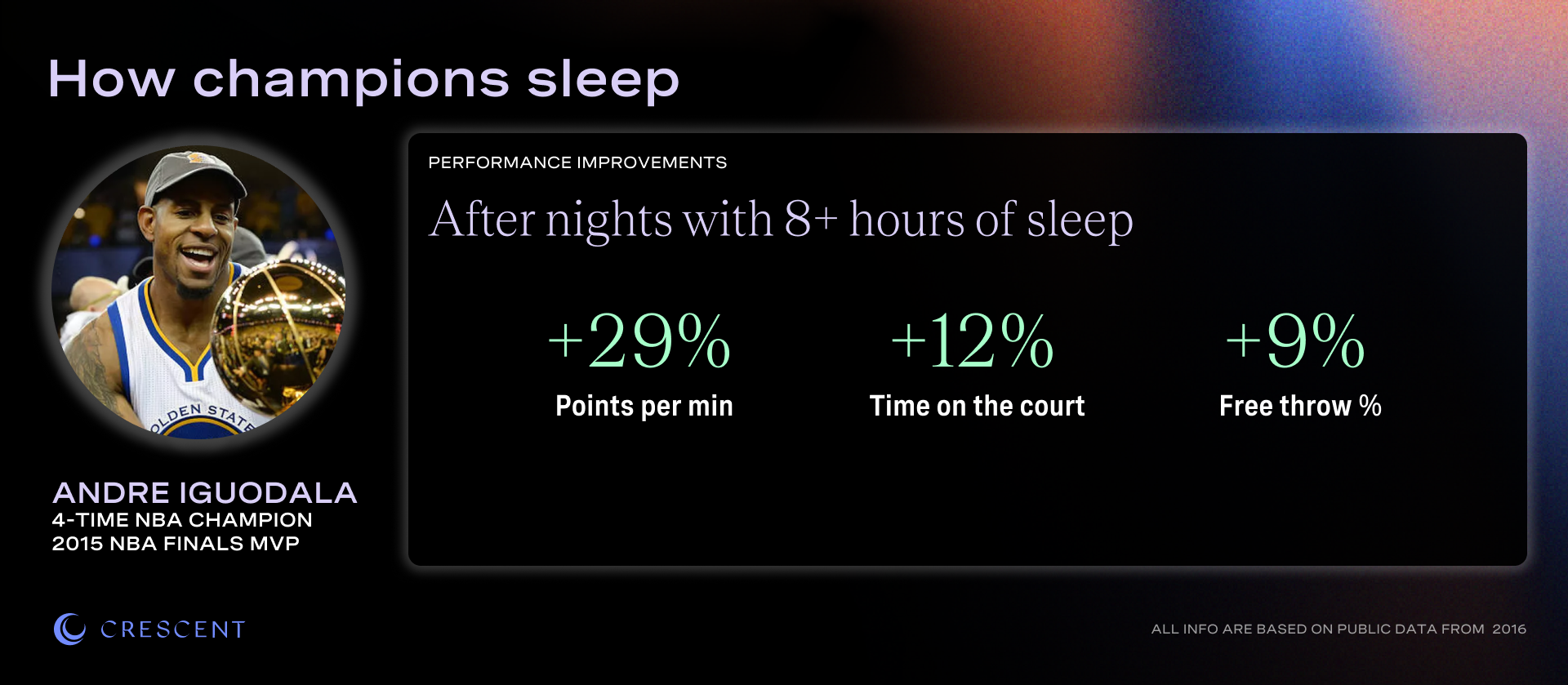
According to statistics collected by Jawbone, Andre Iguodala exhibited a 29 percent gain in points per minute and a 37 percent drop in turnovers per game when he slept more than 8 hours.
A study of the usage of Whoop among NCAA teams saw improved sleep time, sleep quality, and reduced injuries by a significant margin (60% fewer injuries for those using Whoop).
A Stanford study of men’s basketball players who extended their sleep to 10 hours a night experienced several positive outcomes. The players ran faster in both half-court and full-court sprints. Their shooting improved by at least 9% for both free throws and three-point shots. The athletes also reported improved physical and mental well-being.
Male and female swimmers who extended their sleep to 10 hours saw many performance improvements, including faster reaction times off diving blocks, improved turn times, and increased kick strokes. Swim times for 15-meter sprints also got a bump. Plus, the athletes experienced better mood and decreased daytime sleepiness and fatigue.
HRV and other metrics to improve sleep, recovery and training
Using advanced signal processing and data analytics, from wearable trackers, we can measure physiology and quantify stress — and better listen to signals from the body to help athletes of all levels better balance training and lifestyle stressors, for better performance.

In response to the stress, challenges, and stimulus we take on during exercise and training, our body is continuously re-adjusting to maintain a state of balance, or homeostasis. In particular, stress causes corresponding reactions in our heart rate, blood pressure, glucose level, hormones, etc. and our autonomic nervous system, like an engine of a car, works to keep everything in balance.
The autonomic nervous system consists of two branches:
- The sympathetic nervous system (often called “fight or flight”) reflects responses to things like stress and exercise, and increases your heart rate and blood pressure.
- The parasympathetic nervous system (often referred to as “rest and digest”) handles inputs from internal organs, like digestion or your fingernails and hair growing. It causes a decrease in heart rate.
Heart rhythm at rest, in particular, is regulated by the parasympathetic branch of the autonomic nervous system, the one in charge of rest and recovery, and is an important signal from your body you can use to help you track your adaptation to stress, and correspondingly, your recovery.
Heart rate variability comes from these two competing branches simultaneously sending signals to your heart. If your nervous system is balanced, your heart is constantly being told to beat slower by your parasympathetic system, and beat faster by your sympathetic system. This causes a fluctuation in your heart rate: HRV.
When you have high heart rate variability, it means that your body is responsive to both sets of inputs (parasympathetic and sympathetic). This is a sign that your nervous system is balanced, and that your body is very capable of adapting to its environment and performing at its best.
On the other hand, if you have low heart rate variability, one branch is dominating (usually the sympathetic) and sending stronger signals to your heart than the other. There are times when this is a good thing – like if you’re running a race you want your body to focus on allocating resources to your legs (sympathetic activity) as opposed to digesting food (parasympathetic activity).
Learn more:

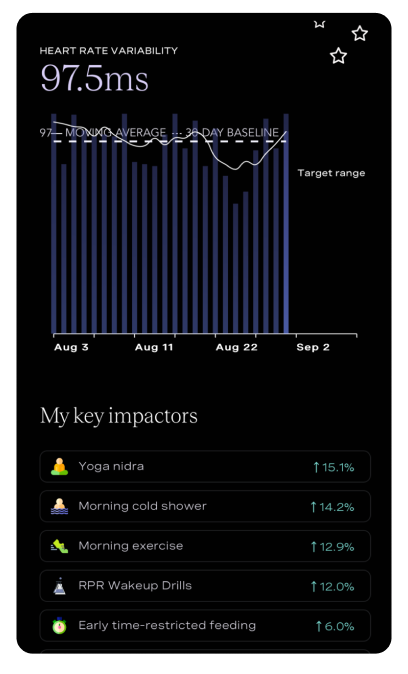
Measuring HRV is an effective way to capture how our body is doing while trying to maintain a state of balance in response to different stressors (training, lifestyle, etc.).
Training factors include the frequency and intensity of your workouts. If you go extra hard today, or for several days in a row, your HRV is likely going to take a hit. There are also many other choices you make each day (lifestyle factors) that significantly affect your heart rate variability, ranging from what you put into your body, to the quality and consistency of your sleep.

And lastly, there are biological factors that are out of your control, like age, gender and genetics – some people are just born to have higher HRV than others.

Rather than sticking to a predetermined workout schedule, modifying the intensity and duration of your physical activity based on your heart rate variability will allow you to train smarter and more efficiently. When your HRV is high, your body is prepared to take on a greater workload. When it is low, it’s a sign to cut back.

Tracking your HRV trends over time, allow you to understand if your training is leading to an “optimal,” “overreaching” (which can be functional or non-functional), or “restorative” state.
Learn more about how data is being used to power performance in our expert Q&As:
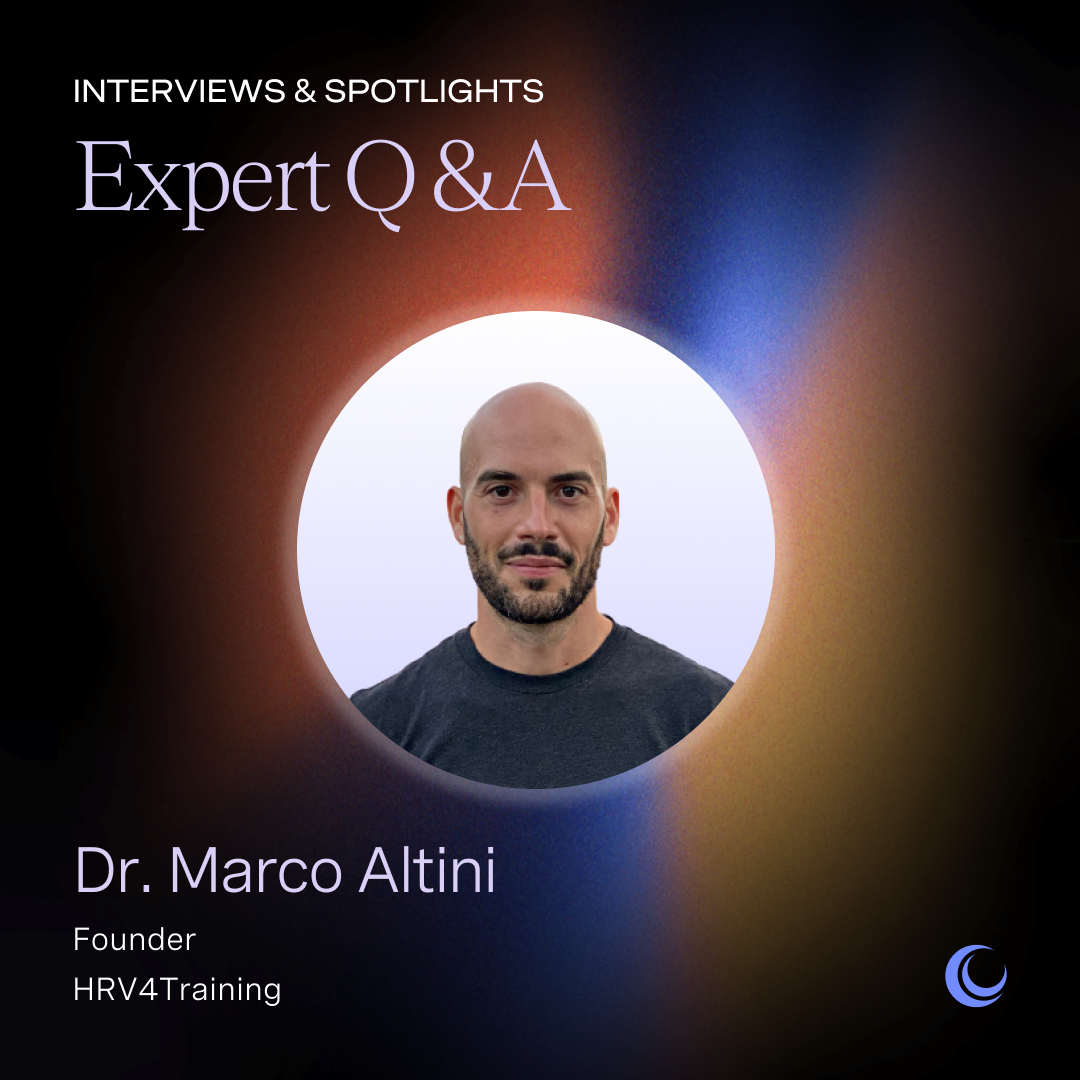

Science-based protocols for your sleep, recovery, and training
There are a lot of protocols out there that claim to boost recovery. Here's a few of our favorite, science-based protocols our team of experts have covered below:
NSDR
Non-sleep deep rest, or NSDR, is a term coined by sleep scientist Andrew Huberman, PhD, professor at Stanford University's School of Medicine. In fact, it's just another name for a centuries-old practice called yoga nidra, which means yoga sleep in Sanskrit. The goal is to access a conscious sleep state and totally relax your brain, releasing unwanted tension in your body and achieving a sense of calm.
Athletes can use NSDR as an alternative to napping, to recharge and recover from day-to-day training.
Learn more:

Cold immersion, alternative heat, and other types of heat therapy
In recent years, cold plunges and cold showers have surged in popularity, with some evidence of boosting recovery through reducing inflammation and other potential benefits to our metabolism.
A recent study found that athletes who immersed themselves — their whole selves — in cold water for 10 minutes after an evening workout dropped their core body temperature, had fewer nighttime arousals, and got more deep sleep within the first 3 hours of going to bed. But not all studies on taking the cold plunge have been as promising.
Learn more:

Hydration
We usually think about staying hydrated (if we think about it at all) during sweltering summer days or during a training session. But new research has begun to link proper hydration and high-quality sleep. Studies have shown that inadequate hydration can negatively impact a good night’s rest and recovery.
Learn more:

Our concluding advice for athletes
The athletic industry has finally recognized that proper sleep health is integral to peak performance. Which is why professional athletes and sports teams, including U.S. Olympic teams, have brought on dedicated sleep specialists.
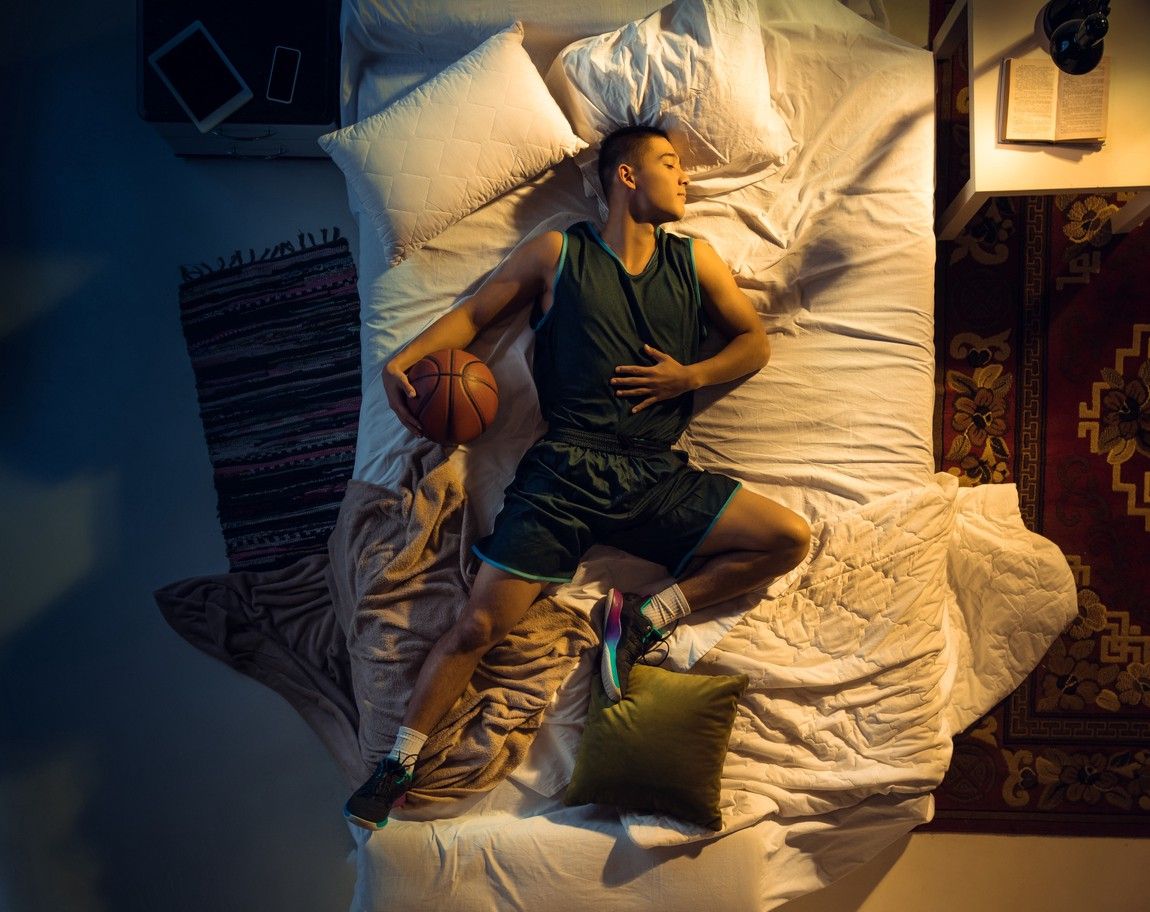
Even if you're not a professional athlete, you can utilize and implement the cutting-edge protocols and programs that the pros use.
Crescent Health is working on making data-driven performance accessible to everyone. Crescent helps athletes, professionals, busy executives, and anyone who wants to improve their sleep health, through personalized programs and coaching.
If you're an athlete interested in improving your sleep, recovery, and performance, you can sign up for Crescent's early access below: